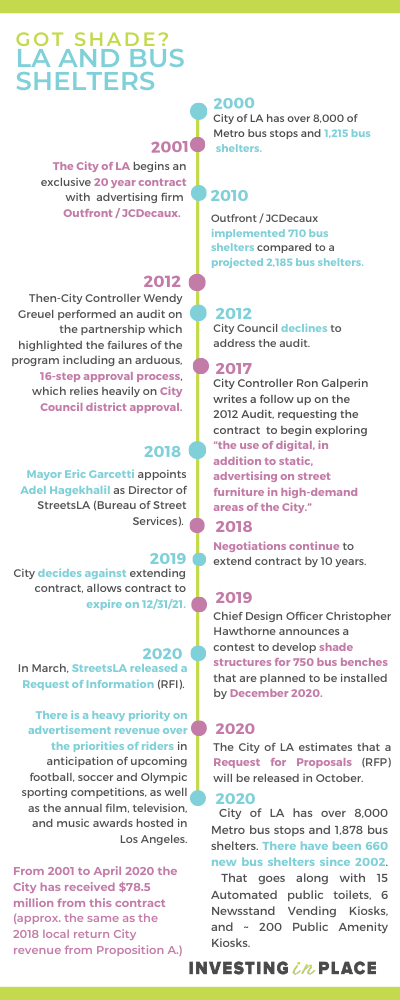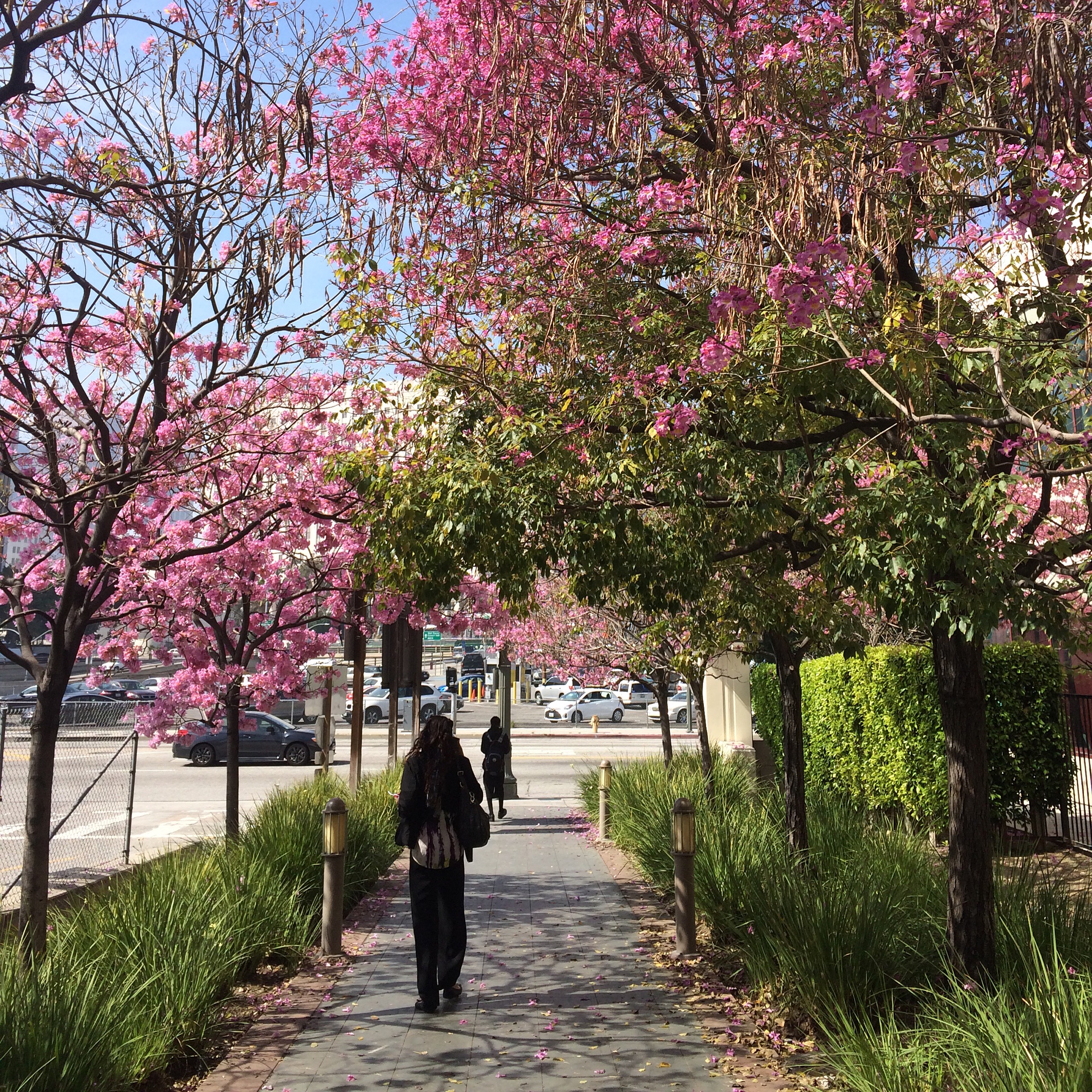In December of 2019, Los Angeles Mayor Eric Garcetti brought up shade as an equity issue.
He said: “Think about an elderly Angeleno who relies on public transit to get around her neighborhood,” he continued. “Imagine her standing in the blistering sun in the middle of July waiting for the bus, with hot, dark asphalt. She deserves to be every bit as comfortable as her counterpart in another ZIP code in town.”
At Investing in Place, we agree that shade is an equity issue. The Urban Heat Island effect, which is caused by structures and infrastructure absorbing heat – typically in urbanized communities that lack parks and green spaces.
This makes it very difficult for bus riders to stay cool, comfortable and protected from the sun. If current climate change trends are to continue, it is likely that there will be more hot days in Los Angeles. For instance, in Downtown Los Angeles, extremely hot days (95°F or above) will increase from 6 to 16 days by 2050. The San Fernando Valley is expected to see 92 days of extremely hot days by 2050.
With an increase of hot days, it is communities of color who are disproportionately affected by a lack of shade the most. According to LA Metro’s data, 66% of bus riders are Latinx and 15% of bus riders are Black. This follows a familiar trend of transportation investments historically being underfunded in working-class Black and Brown neighborhoods, while wealthier and whiter neighborhoods receive greater infrastructure funding.
So what is the City of Los Angeles doing to ensure that people who ride the bus are protected?
Historically, the City of Los Angeles has fallen short on providing bus shelters throughout its 19 year partnership with the firm Outfront / JCDecaux.
A quick recap:
(Link to more detailed timeline here)
Currently, the City of Los Angeles has 1,878 bus shelters. Bear in mind, the City of Los Angeles had 1,215 bus shelters installed before the 2001 contract. In the past 19 years the city has only added 660 new bus shelters since 2002. That goes along with 15 automated public toilets, 6 newsstand vending kiosks, and approximately 200 public amenity kiosks. Plus bus shelters have often been deployed in wealthier neighborhoods where advertising revenue is higher. This is part of the reason why two of the council districts that cover West LA – Council District 5 (Koretz) and Council District 11 (Bonin) – have more bus shelters than other parts of Los Angeles.
Therefore, it is often nonwhite, working-class neighborhoods that lack bus shelters. With the present contract, approving permits for bus stop shelters takes 16 steps and each bus stop must be approved by the city council member whose jurisdiction the bus stop is in. City staff have shared that they often encountered that shelters would be permitted by the bureaucracy and then just sat on the Council Office’s desk never getting affirmative approval as the final step.
So what solutions are available to ensure that communities of color have bus shelters that protect them from the heat and extreme weather?
Around this time last year, the city’s chief design officer Christopher Hawthorne also announced a workshop where design firms will develop “cost-effective” shade structures for the 750 new bus benches the city plans to install by December 2020. This is a good start, but structural reform is needed in the long-term to ensure that communities of color have adequate bus shelters.
Structural change at the city level is sorely needed. One major change that is needed is to cut the steps required to approve bus stop shelters. This is an important step to match StreetsLA’s goal of providing at least 75% coverage of bus shelters per council district.
The case to put people over commerce becomes even stronger when one realizes that the city’s street furniture contract only generated $78.5 million in revenue in almost 20 years from advertising.
At Investing in Place, we fear that with the upcoming 2022 Superbowl, 2023 College Football Championship, the 2026 World Cup, and the 2028 Olympic Games the city will once again prioritize profit over people. As we have seen with the failure of the city street furniture contract overpromising on bus shelters and underdelivering, prioritizing advertising revenue when installing bus stops is a losing strategy that will affect working Angelenos the hardest.
Los Angeles as a whole needs to plan for the immediate needs of the community instead of prioritizing advertising space for tourists that will visit for a couple of weeks throughout the year. As well as providing much needed shade, the city needs to think on a bigger scale and conceptualize what amenities would improve the lives of the people who use the streets.
Regarding the new street furniture contact for Los Angeles, we ask:
- Street furniture contracts must prioritize the Angelenos who have to live with the outcomes of the City’s decisions. For two decades, transit riders in Los Angeles have suffered from a street furniture contract that overpromised and underdelivered. As the city prepares to enter into a new multi-year contract, it is imperative that the needs of people walking and riding the bus be considered paramount in the design, placement, and maintenance of street furniture assets.
- Decouple provision of new bus shelters and public toilets from expectations of revenue generation. The last 20 years have shown that street furniture is not an effective revenue stream: Los Angeles received less than $4 million per year on average from this program over the life of the contract. But treating street furniture as a revenue generator can hinder or fully derail efforts to make the City’s public right-of-ways better, safer, and more inviting spaces.
- Prioritize placing bus shelters and other street furniture along Metro’s Tier 1 and Tier 2 routes in the NextGen network. Bus shelters are an integral part of the transit network. The City should not be asking its street furniture to reinvent the wheel when they can instead focus on the plan which Metro is currently implementing to bring a frequent all-day bus network to the City’s busiest transit corridors. The City should direct its contractor to begin by installing new shelters along these routes in order to facilitate the development of a world-class transit network on city streets.
- Return any revenue from commercialization of the public right-of-way to communities in need. The revenues from the previous street furniture contract were split between the General Fund – where they were a drop in the ocean – and independent accounts maintained by Council District Offices. The City should instead utilize existing definitions of High Need Communities in programs such as Vision Zero and Safe Routes to School to provide funding back into communities impacted by unsafe public spaces. These monies should benefit our communities and help to make them more accessible than they have been in the past.
- Set minimums, not maximums, for bus shelter installation. Los Angeles needs bus shelters badly. As the City continues to warm due to climate change, the waiting environments on our streets have already become dangerous. In contrast to the last contract, this time the City should look to get as many new bus shelters installed as possible, even above the coverage of 75% of riders that StreetsLA has targeted. To accomplish this language should be tailored to set minimum benchmark progress with defined penalties for failing to meet the marks. Incentives should be provided using City dollars earmarked for transportation purposes for the contractor to exceed these minimums in every benchmark period.
We will be following this story closely, and provide any updates. And partner organizations are invited to collaborate with us on our advocacy asks.
Update (10/28/20): Bus Shelter Project Comment Letter
https://investinginplace.org/wp-content/uploads/2020/10/Comment-Letter-Bus-Shelter-Project.pdf












You must be logged in to post a comment.